
7 Fascinating Ways Ancient Cultures Mummified Their Dead
Mummies have long captured the imagination of people all over the world. These preserved remains offer a fascinating glimpse into the lives, beliefs, and traditions of ancient cultures. From the elaborate mummification practices of the ancient Egyptians to the natural mummies of the Aleutian islanders, each culture had its unique way of preserving its dead. The mummies of the Chinchorro people and the Guanche people, for example, were among the oldest ever discovered, while the mummies of the Aztecs were highly ceremonial and were believed to possess spiritual power. Even the ancient Chinese and Tibetans had their own mummification methods. The mystery surrounding these preserved bodies continues to fascinate us, and as we uncover more about their stories, we gain a deeper understanding of the cultures that created them.
1. Egyptian- The Most Famous
When people think about mummies and mummification methods, the first thing to come to mind is, of course, ancient Egypt. In Egypt, mummification was a complex process used to preserve people’s bodies for their journey to the afterlife.
The process was also quite grizzly. It began with the removal of organs, except for the heart (which was believed to be where the soul resided). The rest of the major organs were placed in canopic jars which were buried with the mummy. Not all the organs were saved, however. The brain was somehow removed via the nostrils using a hook. Deemed unimportant, it was then thrown away.
The body was then washed with water from the Nile before being dried with natron, a special, naturally occurring salt. The drying process usually took about 40 days, with the body being buried in, and packed with natron. Once dry, the body was wrapped in linen bandages and decorated with amulets and spells meant to protect the deceased on their upcoming journey.
The head was then adorned with a mask or headdress, often depicting the deceased as a god. This “finished” mummy was then placed in a series of Russian doll-like coffins, with the outermost coffin being heavily decorated with more designs, spells, and inscriptions.
That is, if you could afford it. By no means were all Egyptians mummified. Mummification was an expensive, time-consuming process that was reserved for those that could afford it or enjoyed a high enough social status. Even then, not all mummies were created equal, and the degree of mummification depended on the deceased’s wealth and status. Likewise, the elaborate Russian doll-like coffins were only for Egypt’s most rich and famous.

The mummification method of bodies of people from different social classes differed. Those from the elite or nobility was complex and time consuming, such as that used for the mummified body of Amenhotep I. (Public Domain)
For those who could afford to be mummified, the process was conducted by skilled embalmers. The Greek historian Diodorus described them as, “worthy of every honor and consideration, associating with the priests and even coming and going in the temples without hindrance, as being undefiled.” Unsurprisingly, which embalmer you got, and which method of embalming you received depended on your social status.
The process also evolved over the centuries. Mummification was seen as one of the most important parts of Egyptian religion as it preserved the soul for its journey to the afterlife.
- Solved: the mystery of Britain’s Bronze Age mummies
- Viruses Sleeping in Mummies—Could Ancient Corpses Lead to Modern Epidemics?
2. Inca- A Natural Approach
The Inca process of mummification wasn’t quite as “hands-on” as the Egyptian method. The Inca preferred a more natural mummification method, using natural preservation rather than artificial methods. The results were similar.
The Inca believed that mummification allowed the dead to travel to the afterlife and still maintain a connection to their community. The deceased would be carried up into the mountains and then placed in a seated position where the body would be exposed to the cold, dry mountain air and then the sun, which dried it out.
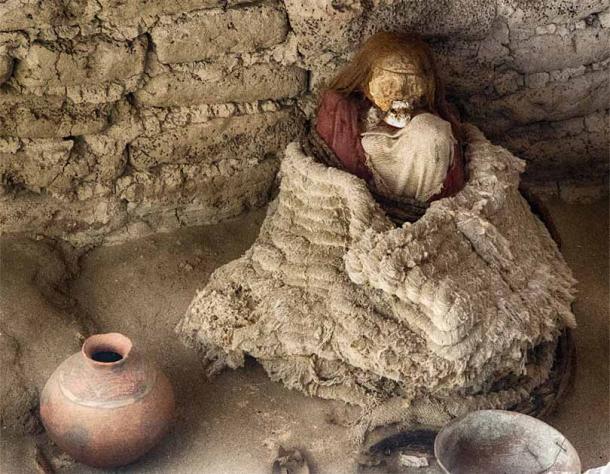
Nazca mummy at the cemetery of Chauchilla near Nazca, Peru. (Matthias Kestel/Adobe Stock)
Once the body was dried, it was collected and wrapped in textiles and adorned with personal belongings like jewelry. The process was usually reserved for members of the Inca elite, like leaders, priests, or those who had made significant contributions to Inca society. Inca’s rare sacrifice victims often fell into this last category.
The mummies were often placed in tombs or special chambers where they were seen as sacred objects. In some cases, the mummies were removed from their tombs during important ceremonies and paraded through the streets to celebrate the individual's life and achievements. The Inca also believed that the mummies had the power to communicate with the living and provide guidance and protection.
3. Chinchorro Mummies- Predated Egyptian Mummies
Egyptian mummies might be the most famous, but they weren’t the first, nor were they the most impressive. The Chinchorro mummies are a collection of mummies found in the Atacama Desert of modern-day Chile and Peru. They are some of the oldest mummies in the world, with some dating back as far as 7000 BC.
What makes the Chinchorro mummies so fascinating is that the Chinchorro people appear to have used a range of different techniques to mummify their loved ones. These methods changed over time but are divided into roughly three groups.
Around 29% of found Chinchorro mummies underwent natural mummification. Chile’s naturally arid air and the high salt content of the soil meant that buried bodies simply dried out before they decayed.
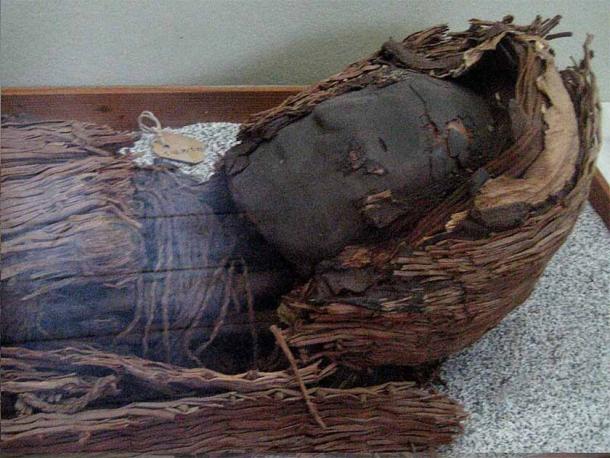
Head of a mummy from the Chinchorro culture, found in Northern Chile. (Pablo Trincado/CC BY 2.0)
Next was the black mummy technique. This process was even more complex than the Egyptian method, and far more macabre. It involved the body being completely dismantled before being put back together piece by piece. The arms, legs, and head were each separated from the torso and treated separately.
Then, the internal organs were removed. They were replaced with plant fibers and animal hair. The body was then covered in a layer of clay and ash, which functioned as a preservative. Sometimes the skin was removed, and the individual body parts were heat treated.
The body was then reassembled and covered with a white ash paste and animal hair and plant fibers were used to fill in any missing pieces. The skin was then reattached, and clay was used to re-mold missing facial features. The body was then painted to give it a more natural color.
By around 2500 BC this technique had evolved into the Red mummy technique. It was much the same but just a little more refined. Much smaller incisions were used to remove the organs and the body was no longer dismembered. There was also a greater emphasis on preserving the body's natural appearance.
The process evolved one final time. The latest Chinchorro mummies gave up on many of the grizzly aspects of mummification. The body was mostly untampered with and simply covered in a heavy layer of clay that acted as a kind of cement. This clay was then decorated and placed in a tomb while the body desiccated within, completely concealed.
4. Guanche- Evolved Over Time
The Guanche mummies are a collection of mummies found in the Canary Islands, which were inhabited by the Guanche people before the arrival of Europeans in the 15th century. Guanche mummification has been divided by experts into three methods: evisceration, preservation, and stuffing. Different mummies show different combinations of these three methods.
Some mummies showed signs of evisceration. Incisions were made in the body so that the internal organs could be removed. Some bodies would be eviscerated and then their cavities filled with a mud-like substance. Another substance was also used as a filler beneath the skin, but its makeup is a mystery.
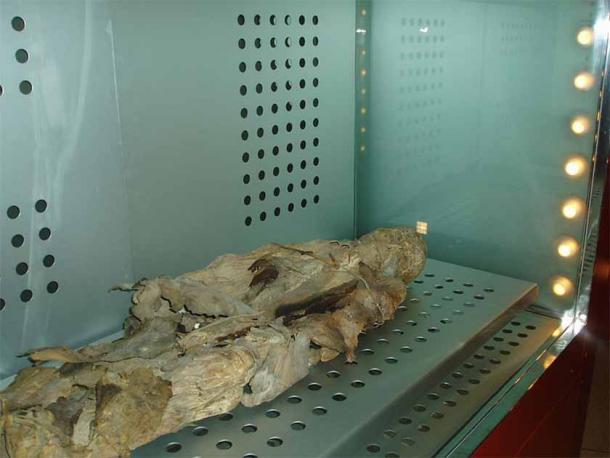
Former mummified inhabitant of the Canary Islands, located in the Museum of Nature and Man of Santa Cruz de Tenerife. Known as the "Mummy of San Andrés. (Cardenasg/CC BY-SA 3.0)
The outer body was usually preserved via a mix of natural resins and wrapped in animal skins. The resins, made from minerals, plants, and fats would be mixed and then spread over the body, which would then be dried (either naturally, or through smoking).
The mummy was then wrapped in more animal skins and laid to rest. The higher someone’s status, the more skins they were wrapped in. The Guanche mummies are notable for their preservation and level of detail. Some mummies still have skin and hair intact, and others have intricate tattoos and patterns on their skin.
Sadly, there’s a lot we still don’t know about the mummification methods used by the Guanche. The vast majority of them have been lost due to looting and desecration. Many of them were lost due to the popularity of mummia, a kind of pharmaceutical made from crushed mummies.
5. Buddhist Mummies- Self Mummification
Who needs an embalmer when you can do it yourself? Found largely in Tibet and other parts of the Himalayas as well as Japan, Buddhist Mummies (also known as self-mummified monks) offer an astonishing look at one of the world’s rarest forms of mummification.
These monks believed self-mummification would allow them to achieve enlightenment and continue to guide their followers from beyond the grave. They began the process by following a strict diet and meditation regimen, which the monk would follow for several years prior to death. The diet consisted of a special tea made from the sap of a local tree, which had strong preservative properties. The monk would also engage in prolonged periods of meditation.
The prolonged periods of meditation and special diet were meant to reduce body fat and promote dehydration. This rather unpleasant process was also an act of self-punishment meant to aid the monks on the path to enlightenment.
After this diet killed the monk, they would be placed in a small chamber or cave where the salt and natural elements would dry them out naturally. The process could take several years, during which time the body would be periodically checked and treated with special oils and herbs to prevent decay.
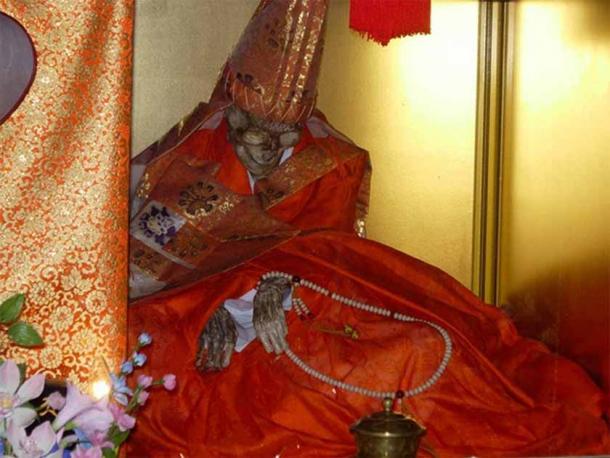
The body of Shinnyokai Shonin, found in Oaminaka, Japan. He had practiced self-mummification. (Credit: Ken Jeremiah)
Once the body was fully mummified, it would be placed in a sitting position and adorned with robes and other ceremonial items. The mummies were often considered to be sacred objects and were believed to possess great spiritual power. Some were even put on public display in monasteries or other sacred sites.
Ascetic monks in Japan followed a similar path but were buried alive in a pine box full of salt. This box was connected to a tube which provided them with air. The monk periodically rang a bell to signal he was still alive. When they stopped ringing the bell the tube was removed. The monks' pre-death diet and the salt in the box then did the job of mummification. Unsurprisingly, the practice has been banned.
6. Aleutian Islanders- All Natural Mummification Method
The indigenous people of the Aleutian Islands (near Alaska) were known for their unique form of mummification which was 100% natural. The islanders believe that when someone died their soul left the body but then returned. It could only return, however, if the body was well preserved.
The mummification process began by putting the body in a sitting position on a bed of spruce branches. It was then wrapped in animal hides with just the head left exposed. Once wrapped, the body was placed in a shallow pit where it was covered with rocks and soil. The soil acted as a preservative while the region's dry climate dried out the body and preserved it.
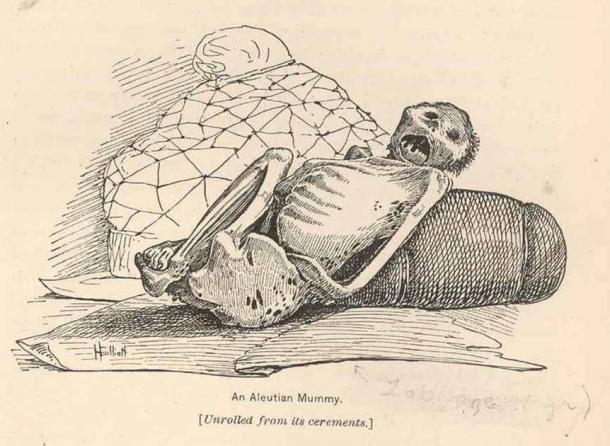
Aleutians mummified their dead by removing the organs and stuffing the cavity with dry grass, then wrapped it in animal hides. (Public Domain)
Over time the body would completely dry out, with the skin and hair becoming leathery and brown. The mummies were often buried in family graves or in communal burial sites. What made the Aleutian tradition so special is that mummification wasn’t reserved for the elite, anyone could undergo the process.
7. Aztec- Communing with the Gods
The Aztecs were an indigenous civilization that lived in central Mexico from the 14th to the 16th centuries. They had a complex system of beliefs and rituals, including a form of mummification that was reserved for the most prominent members of society, such as warriors and rulers.
Aztec mummification was a long and complex process that began with the extraction of the organs from the body. The organs were then placed in special vessels and buried with the mummy. Next, the body was cleaned and coated in a mixture of resin, wax, and other materials, which helped to preserve it.
After the coating was applied, the body was wrapped in multiple layers of cloth and placed in a sitting position. The mummies were often adorned with elaborate headdresses, jewelry, and other ceremonial items, and were placed in tombs or other sacred sites.
The Aztecs believed their mummies held strong spiritual powers and that they could be used to communicate with the gods. People would often visit the mummies to consult them for spiritual guidance and help.

A hieroglyph depicting the mummy of the deceased Aztec ruler, Ahuitzotl, followed by his living successor. (Public Domain)
Today, few Aztec mummies have been discovered, and most of them are housed in museums or other cultural institutions. They provide a unique and fascinating glimpse into the beliefs and practices of an ancient civilization and continue to be studied by archaeologists and anthropologists to better understand the customs and traditions of the Aztec people.
- The Deadly Toxin Found in the World's Oldest Mummies (Video)
- School children uncover 7,000-year-old mummy in Chile
Conclusion
Mummification has been practiced by many cultures throughout history, each with its unique methods and beliefs. While the practice of mummification has largely fallen out of use in modern times, the mummies that have been discovered continue to fascinate and intrigue us, providing a window into the beliefs, customs, and practices of ancient societies.
From the elaborate mummies of the ancient Egyptians to the natural mummies of the Aleutian Islanders and the Chinchorro people, to the ceremonial mummies of the Aztecs and the ritualized mummies of the Tibetan Buddhists, each culture's approach to mummification tells us something about their worldview, their religious beliefs, and their relationship with death and the afterlife. Despite the differences between these cultures, one thing remains constant - the desire to preserve and honor the dead, and to keep their memory alive for generations to come.
Top image: Head and shoulders of an Egyptian mummy, the best-known of mummification methods. Source: Andrea Izzotti/Adobe Stock
References
Editor. 2023. Mummies in Ancient Egypt and the Process of Mummification. Available at:
https://www.historyonthenet.com/the-egyptians-mummies
Editors. 2018. Mummy History. Available at:
https://www.history.com/topics/folklore/history-of-the-mummy
Cockburn. A et al. 1998. Mummies, Disease and Ancient Cultures. University Press, Cambridge.
Klein. C. 2018. CT Scan Reveals Mummified Monk Inside Ancient Buddha Statue. History. Available at:
https://www.history.com/news/ct-scan-reveals-mummified-monk-inside-ancient-buddha-statue















